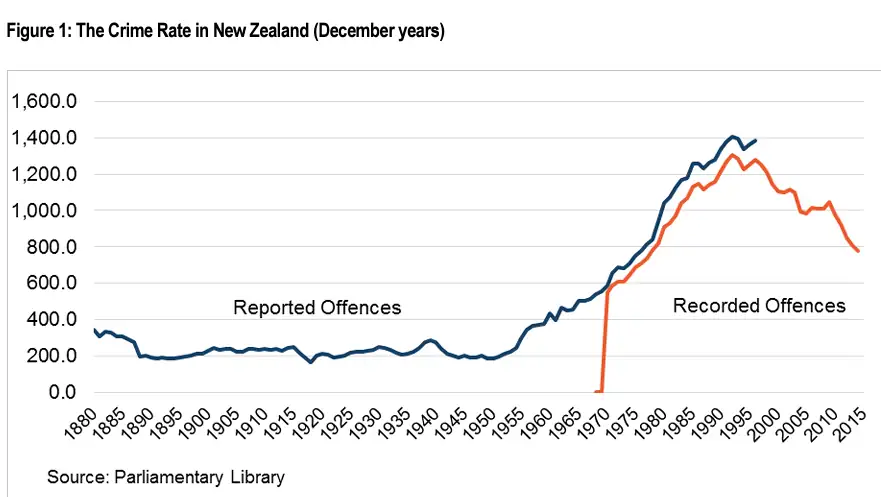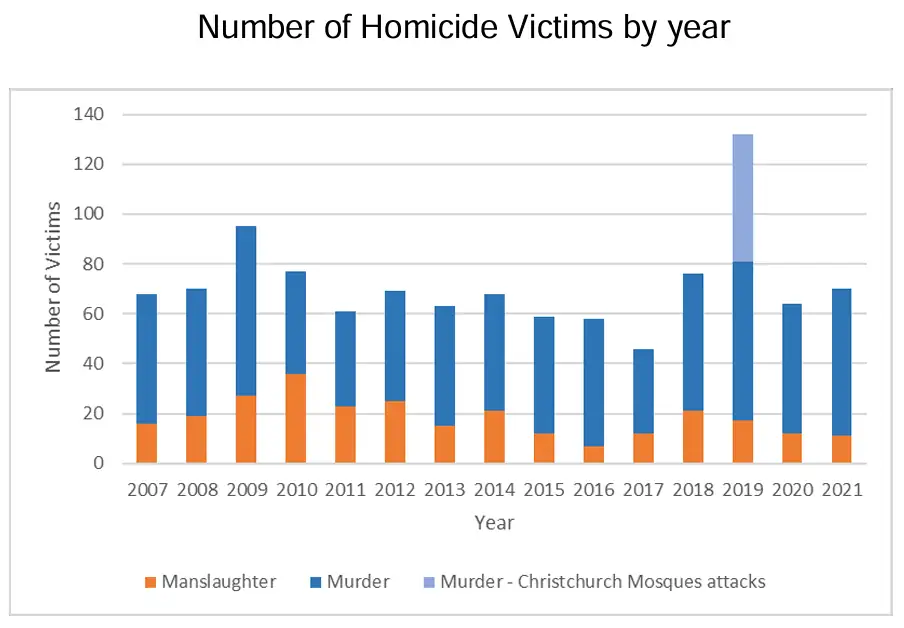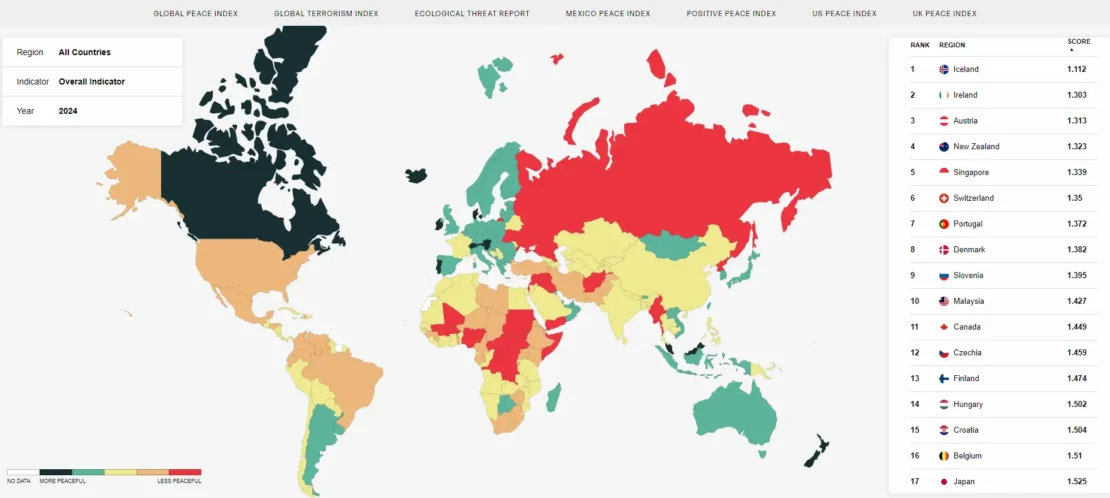New Zealand Crime Statistical Overview
Written by Mark Dash | Last updated: August 3, 2024
Under a Creative Commons license (sharable with link attribution)
New Zealand is consistently ranked as a top-five most peaceful country in the world, but the fact that it is home to probably more patched gang members per capita than any other country in the world is driving the decline in the Global Peace Index (GPI). Gangs have recently started to get organised and involved in drug trade.
In May 2024, the New Zealand Police chief Andrew Costner announced the formation of a National Gang Unit that will consist of 25-30 officers, plus seven in districts. This will be joined by new legislation that will ban gang patches in public, allow the police to disperse gang members, and, crucially, have gang membership as an aggravating factor in court sentencing.
As this research paper will show, New Zealand is a generally peaceful country but one prone to violence, especially in areas that are poorer than the rest of the country. The propensity for young people from poor backgrounds to join gangs is alarming, and it’s not going away.
Even if the police started taking gangs seriously, any reduction in gang crime will have to deal with the root cause of gang-related crime, which is inequality and higher levels of deprivation.
What rank is New Zealand in crime?
New Zealand has been ranked fourth-most peaceful country in the world in 2023 and 2024 by the Global Peace Index (GPI), and is ranked 78th according to the crime rate and 66th by homicide rate.
Homicide rate remains stable and consistent with other developed countries. One area in which New Zealand is much better than other Western countries is drug use – while recreational drug use is very common, there is a notably small number of heroin users.
New Zealand Crime Rate

According to the crime index, not to be mistaken with a crime rate per 100,000 inhabitants, with an index of 47.1, New Zealand is 78th in the world, ranked similarly as Australia, United Kingdom, Italy, Sweden and the United States.
Statistics show that the crime rates were low in the first half of the 20th century, but rose steeply from circa 1950, peaking around 1992 and showing a steady decline since then. A similar pattern is visible in most Western countries.

It must also be noted that crime reporting in New Zealand isn’t at a very high rate. Many offences, especially sexual ones, go unreported.
Less than half of all reported crimes were resolved – with the rate dropping slightly from 47.8 per cent in 2009 to 47.5 per cent in 2010. This is indicative of a trend where police got much better in the period from 1998 to 2014. However, in 2014 the way statistics are measured has changed drastically so the pre- and post-2014 numbers can not be compared to one another. For serious violence the resolution rate is 72% and the murder resolution rate is 85%.
Venezuela is the country with the highest crime rate in the world. Of developed countries, South Africa is the worst, being ranked third overall, with a notably high rate of violent crimes.
Types of Crimes Committed
The New Zealand Crime and Safety Survey (NZCASS) estimated that in 2014, the four major classes of crime incidents were assault (27.3%), threat of force (21.4%), burglary (10.8%) and sexual offences (9.9%).

According to the same 2014 report, five offence categories were responsible for 80% of all crime committed in the country. Theft offences were most common at 34%, followed by burglary, a form of theft, with 15.2%, property damage at 11.5%, acts intended to cause injury at 11.4% and public order offences at 7.6%.
Homicides account for 0.02% of all crimes in New Zealand.
Homicides in New Zealand
In June 2024, the New Zealand Police released a report for 2022 that includes crimes done by the end of 2021.
The trend generally remains stable with an average of about 68 homicide victims in New Zealand per year, for a rate of 1.327 homicide victims per 100,000 inhabitants, which would rank New Zealand #66 worldwide of 204 countries, with Australia at #39 faring much better with a homicide rate of 0.833, while Japan, Hong Kong, Switzerland, Singapore, even China, all have a homicide rate under 0.500. For comparison, the homicide rate in the US is 6.300, and it goes above 20 in countries such as Colombia, Mexico, South Africa and Jamaica.

Between 2007 and 2021, 43% of all homicides didn’t include use of a weapon, which means they were done with bare hands. 23% of homicides were done with a knife or other stabbing weapon, while 17% involved the use of a firearm.
Of all victims, 75 per cent were victims of murder, with the other 25 per cent being manslaughter. Males represent exactly two-thirds of all victims.
More than 40% of all homicides didn’t include a weapon.
2024 Police Homicide Report at a glance:
- Between 2007 – 2021 there were 1,076 people killed by homicide (murder and manslaughter).
- Māori account for approximately a third of homicide victims, while accounting for 17.3% of the national population.
- Males represented 66 percent of all victims.
- The lowest annual homicide figure of 46 was in 2017.
- About three fourths of all homicides were murders.
- Of all family-linked homicide victims, 44% were male and 56% were female.
- Around 15% of homicides were committed by a current or ex-partner – 74% of these victims were female.
- 621 (about 58 percent) homicides occurred in dwellings and 296 (about 28%) in outdoor public places.
Children under the age of five made up 11 percent of homicide victims.
Crime statistics by region: Rotorua has the highest crime rate
The South Island has, generally, much safer communities and lower levels of crime, while in comparison the North Island has higher levels of crime, particularly in those areas where there is greater inequality and higher levels of deprivation.
Rotorua tops the list with the highest crime rate in New Zealand, followed by Napier, Palmerston North, Hamilton and Taupo. The lowest crime level was in Selwyn in Canterbury, followed by Central Otago, Southland, the Mackenzie District and Waimate.
Highest crime rates in New Zealand
- Rotorua – 61.2 crimes committed per 10,000 people per month
- Napier – 59.7 crimes committed per 10,000 people per month
- Palmerston North – 54.4 crimes committed per 10,000 people per month
- Hamilton – 53.5 crimes committed per 10,000 people per month
- Taupo – 50.4 crimes committed per 10,000 people per month
- Hastings – 49.4 crimes committed per 10,000 people per month
- Gisborne – 46.6 crimes committed per 10,000 people per month
- Far North – 46.3 crimes committed per 10,000 people per month
Lowest crime rates in New Zealand
- Selwyn – 12.7 crimes committed per 10,000 people per month
- Central Otago – 13 crimes committed per 10,000 people per month
- Southland District – 15.1 crimes committed per 10,000 people per month
- Mackenzie District – 15.8 crimes committed per 10,000 people per month
- Waimate – 17.3 crimes committed per 10,000 people per month
- Carterton – 18.8 crimes committed per 10,000 people per month
- Queenstown – 19.8 crimes committed per 10,000 people per month
- Tasman – 19.9 crimes committed per 10,000 people per month
Gang membership and gang crime
According to the 2007 book Gangs by English journalist Ross Kemp, New Zealand had more gangs per head than any other country in the world, with about seventy major gangs and over 4,000 patched members in a population of, then, 4 million people. In 2019 the Police recorded 6,500 patched or prospective gang members in the country, with the ten main gangs being the Head Hunters, Bandidos, Hells Angels, King Cobras, Black Power, Mongrel Mob, Tribesmen, Rebels, Devils Henchmen and Highway 61.
By June 2021, there were 8,061 patched gang members on the Police Gang List, a 4,000 increase from 2016. By November 2022, the number of gang members on the Gang Harm Insight Centre’s Gang List had risen to 8,357; the highest number ever recorded in New Zealand history.
The Mongrel Mob is the largest gang in the country, with more than thirty chapters and operations in Australia and Canada. It is estimated that over 10% of the prison population in New Zealand are Mongrel Mob members.
With almost 8,900 gang members, compared to 10,700 frontline police officers, and the fact that gang members are being recruited at a higher rate, twice as fast, it is possible that in the near future the number of gang members will overtake the number of police officers. In five police districts this is already the case.
Gangs have recently turned their attention from traditional turf wars and violent clashes to the lucrative business of manufacturing and distributing methamphetamines, mostly speed. This in turn makes gangs much more powerful as they have more money.
Around 2020, the police started saying they are now dealing with real organised crime in New Zealand, for the first time ever.
Cannabis and other illicit drug use
Cannabis is the most widely-used drug in New Zealand. Almost half of adults had used cannabis at some point in their lifetime (46.4%), which represents approximately 1,224,600 people. One in seven (14.6%) adults had used cannabis in the past year. This is, according to the 2006 World Drug Report, the ninth-highest cannabis consumption in the world, just behind Jamaica. Papua New Guinea, Canada, Palau and the United States top the list.
Other than cannabis, Kiwis are consuming BZP party pills a lot, with methamphetamines and ecstasy also popular, and in line with worldwide trends, methamphetamines are rapidly overtaking cannabis as the recreational drug of choice. Heroin and cocaine are almost unheard of.
The prevalence of having used drugs for recreational purposes in the last 12 months was highest for the following drugs:
- cannabis (14.6%)
- BZP party pills (5.6%)
- ecstasy (2.6%)
- amphetamines (2.1%)
- LSD and other synthetic hallucinogens (1.3%)
Possession of any amount of cannabis is a crime in New Zealand, as in the 2020 referendum 50.7% of voters voted against legalisation. Cannabis is the fourth-most widely used recreational drug in New Zealand, after caffeine, alcohol and tobacco, and the most widely used illicit drug.
A 2023 study that ranked drug harms in New Zealand found that alcohol is the most harmful drug in the country, followed by methamphetamine.
Most New Zealanders over 15 use alcohol at least once a year, and among those who drink, a concerning number use alcohol in a way likely to cause themselves harm (23.8% in 2021/22). The vast majority (79.1%) of New Zealand’s adult population reported drinking alcohol at least once during 2021/22.
Notably, opiates (heroin and similar compounds) are seeing very little use in New Zealand, as the country is ranked #106 according to opiates use, which is inconsistent with other Western countries that are usually in the top third of the list. For comparison, in the UK opiates are six times more popular, and in the US ten times more popular than in New Zealand.
Sexual Violence
One in three women in New Zealand are estimated to have experienced physical and/or sexual violence from a partner in their lifetime. According to the 2019 New Zealand Crime and Victims Survey (NZCVS), only 15% of victims believed sexual assault was a crime. A Ministry of Justice discussion paper exploring improvements to sexual violence legislation reported that around 90 percent of rapes go unreported, making it the least likely crime to be reported.
Māori women are twice as likely as other New Zealand women to experience some form of violence. Half of them have experienced sexual or physical violence, the government report in 2021 claims.
Corruption in New Zealand
New Zealand is regarded as having one of the lowest levels of corruption in the world. In the 2023 Transparency International’s Corruption Perceptions Index that ranks countries by the perceived corruption of the public sector, New Zealand earned the third-highest score worldwide, and the highest score in the Asia Pacific region.
Global Peace Index (GPI): New Zealand #4 but declining
Global Peace Index is a report produced by the Institute for Economics & Peace that ranks countries by their peacefulness. GPI was first launched in 2009, with subsequent reports released annually. The study was conceived by Australian tech entrepreneur Steve Killelea.

New Zealand is consistently being ranked among the most peaceful countries in the world, although the exact position, as well as the GPI Score, have continuously been degrading lately. In 2023, New Zealand has lost its previous position #2 that it held for many years, and is now ranked as the #4 most peaceful country in the world in the last two GPI reports.
| Year | GPI New Zealand | Position | Change |
| 2024 | 1.323 | 4. | = |
| 2023 | 1.313 | 4. | ↓ 2 |
| 2022 | 1.269 | 2. | = |
| 2021 | 1.253 | 2. | = |
| 2020 | 1.198 | 2. | = |
| 2019 | 1.221 | 2. | = |
| 2018 | 1.192 | 2. | = |
Conclusion
If we were to draw conclusions from these reports, we’d say that there’s a definite disparity between crime at the North and South Islands, and that the crime rate is generally declining but that this disparity needs to be addressed, as well as the increase in gang-related crimes. A decline of the Global Peace Index is a cause for concern.
On a brighter note, New Zealand is a very happy and peaceful country with virtually no corruption, and drugs like heroin and cocaine never seem to have gained traction here.
Sources
https://www.economicsandpeace.org/wp-content/uploads/2024/06/GPI-2024-web.pdf
https://www.parliament.nz/mi/pb/library-research-papers/research-papers/from-offences-to-victimisations
https://www.newshub.co.nz/home/new-zealand/2020/11/rotorua-has-highest-level-of-crime-in-new-zealand-selwyn-the-lowest-analysis.html
https://www.police.govt.nz/sites/default/files/publications/homicide-victims-report-2022.pdf
https://www.nzherald.co.nz/nz/gangs-and-meth-new-study-reveals-mobsters-dominate-the-nz-market-even-more-in-northland-and-south-island/J2X67Z7VGFF5HAB4JQKV35JZW4
https://www.newshub.co.nz/home/new-zealand/2018/03/official-new-zealand-murder-map-revealed.html
https://www.odt.co.nz/regions/high-number-illegal-guns-blamed-gangs
https://www.justice.govt.nz/assets/NZCASS-201602-Main-Findings-Report-Updated.pdf
